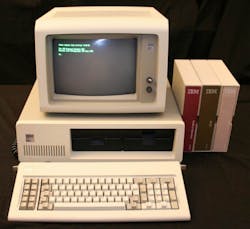As I sat here, thinking about a subject for this blog, my eyes fell upon an old friend—my 1982 IBM PC model 5150; a 4.77 MHz Intel 8088 microprocessor running Microsoft´s MS-DOS. (Yes, I still have it and yes, it still runs, having got me through two jobs and both my kids through their college years—a trusted friend, to be sure.)
A thought that struck me as I mused over that 25 pound hunk of beige steel was how modern in concept it still is. I mean, think about it: it was ground breaking—the first “Volks-computer,” something affordable (although $2,000 in 1982 could buy a really decent used car) and ever so useful.
It was a “virtual machine”: there were loads of MS-DOS based programs for it, and you could write your own in BASIC. You could buy memory, disk drives, even a hard drive (if you changed the BIOS chip). There were expansion boards, like modems and NICs. And: you could buy all this stuff, put it in yourself—and it worked. It was this blend of open architecture, interface commonality, obsolescence resistance and the ability to assume different roles with the same hardware that made it such a good and loyal partner to me and my kids for so long.
So, it got me thinking. In the mil/aero computing world, historically and generally, embedded computers are designed as point solutions. By this, I mean that they are built up with specific interfaces, specific hardware, specific software and do a specific job—like radar processing or analytics or flight control. Often, these subsystems require a lot of “hand-holding” to get them performing well in the end application, simply because they are custom.
Commonality
Why is this? I mean, our military customers are always looking for commonality—OpenVPX, Linux, standard interfaces and so on. Sure, we and our competitors all make standard form factor boards and run standard operating systems and connect with standard interfaces and protocols—but the resulting computing sub-systems are still largely point designs.
Wouldn’t it be great if we could come up with the 2017 mil/aero equivalent of my 1982 IBM PC? Something that was off-the shelf ready—or at least available within weeks rather than months—and that used fast, flexible, low-SWaP base technology that was upgradable as that technology changed? That was modular and had interchangeable interface capability and hosted open standard software so it could be used for lots of different computing needs? That worked like a custom solution—but was deliverable in a fraction of the time it takes our customers to deploy custom solutions today?
Wouldn’t that be great?
It sounds like a pipe dream—right? But then, way back in 1977, Ken Olsen, founder and CEO of Digital Equipment Corporation, famously said that he could see no reason for any individual to have a computer in his home. My trusty IBM PC was the beginning of a revolution that saw him proved very, very wrong. Now, of course, pretty much every home has a computer.
So why couldn’t the mil/aero embedded computing industry see a similar revolution to the one I described above? Well, perhaps it will. And probably sooner than you think. Watch this space.
About the Author

